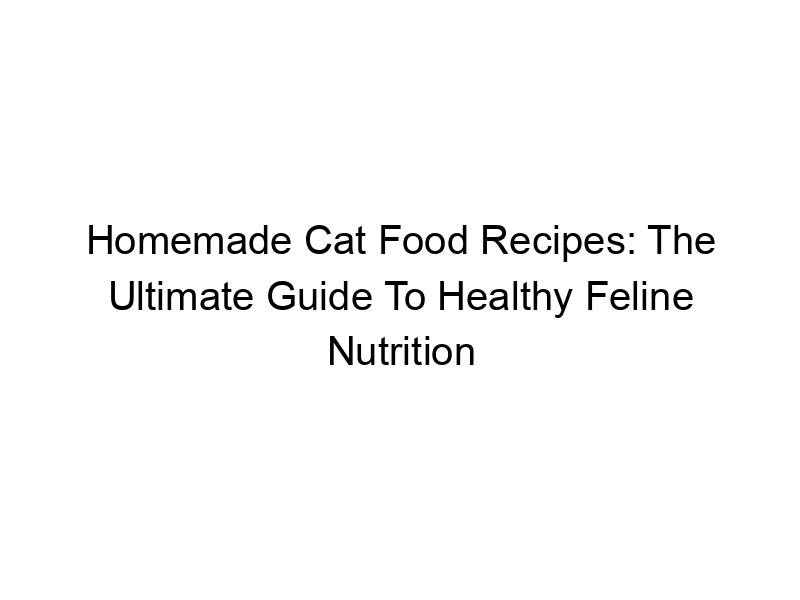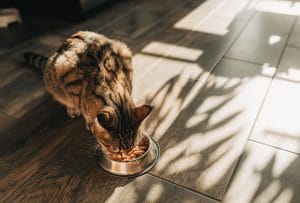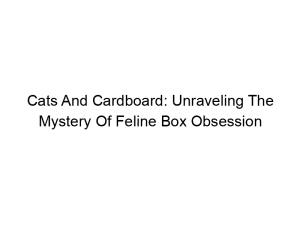Is your cat a picky eater? Are you concerned about the ingredients in commercial cat food? Then you’re in the right place! This comprehensive guide explores the world of Homemade Cat Food Recipes: Healthy and Easy Meals for Your Feline. We’ll cover everything from the basics of feline nutrition to creating delicious and nutritious meals your cat will love. You’ll learn about essential nutrients, recipe ideas, potential pitfalls, and frequently asked questions, equipping you with the knowledge to provide your furry friend with the best possible diet.
Cats are obligate carnivores, meaning their bodies require specific nutrients found primarily in animal products. These include taurine, an amino acid crucial for heart and eye health; arachidonic acid, an omega-6 fatty acid vital for skin and coat; and vitamin A, necessary for vision
and immune function. A balanced homemade diet must provide these in sufficient quantities.
Macronutrients: Protein, Fat, and Carbohydrates
Protein forms the cornerstone of a cat’s diet, providing building blocks for muscles, organs, and enzymes. High-quality protein sources, like chicken, turkey, fish (tuna, salmon, sardines), and eggs, are essential. Fats supply energy and essential fatty acids. Healthy fats include those found in fish oil, chicken fat, and coconut oil (in moderation). Carbohydrates should be minimal, playing a secondary role in energy provision.
The Benefits of Homemade Cat Food
Control Over Ingredients
Homemade cat food offers unparalleled control over ingredients. You can avoid fillers, artificial colors, preservatives, and potentially harmful additives often found in commercial foods. This ensures your cat consumes only wholesome, recognizable ingredients.
Tailored Nutrition
Homemade diets allow customization to meet your cat’s specific needs. If your cat has allergies, sensitivities, or specific health conditions, you can adjust the recipe accordingly under veterinary guidance. This level of personalization is impossible with commercial food.
Improved Digestive Health
Many cats experience digestive issues with commercial kibble. Homemade food, often cooked and less processed, can improve digestion, leading to healthier stools and reduced gas or vomiting.
Potential Drawbacks of Homemade Cat Food
Nutrient Imbalances
A poorly formulated homemade diet can lead to nutritional deficiencies. Without careful planning and potentially veterinary consultation, homemade cat food can lack essential vitamins, minerals, or amino acids.
Time and Effort
Preparing homemade cat food requires time and effort. Consistent meal preparation is necessary, and you must factor in shopping, cooking, and storing the food properly.
Cost
Depending on ingredients and your location, homemade cat food can sometimes be more expensive than commercially available options, particularly if you source high-quality meats.
Choosing the Right Ingredients
High-Quality Protein Sources
Prioritize lean protein sources like chicken breast, turkey breast, beef, or fish fillets. Avoid using fatty cuts, bones, or organs unless specifically guided by a veterinary nutritionist.
Healthy Fats
Include healthy fats such as salmon oil, coconut oil (in moderation), or chicken fat. These contribute to healthy skin and coat, and are energy-rich.
Essential Vitamins and Minerals
While many nutrients are found in whole foods, you might need to supplement with a commercially available feline vitamin and mineral supplement to ensure complete balance. Consulting a vet is crucial here.
Fruits and Vegetables (In Moderation)
Some fruits and vegetables can be added in moderation, such as cooked pumpkin, carrots, or green beans. Always introduce new foods gradually to avoid digestive upset.
Simple Homemade Cat Food Recipes
Chicken and Rice Recipe
This recipe is a classic and easily digestible option. Ingredients: Cooked chicken breast, cooked brown rice, a small amount of cooked carrots or peas, and a feline multivitamin. Combine and serve.
Salmon and Sweet Potato Recipe
Rich in omega-3 fatty acids, this recipe is excellent for skin and coat health. Ingredients: Cooked salmon (bone-free), cooked sweet potato, a small amount of cooked green beans, and a feline multivitamin.
Turkey and Vegetable Medley
This recipe offers a variety of nutrients and flavors. Ingredients: Ground turkey, cooked green beans, cooked carrots, cooked zucchini, and a feline multivitamin.
Recipe Variations and Adaptations
Adapting to Allergies and Sensitivities
If your cat has allergies, eliminate the offending ingredients and replace them with alternatives. For example, replace chicken with turkey or fish. Always consult your veterinarian.
Adjusting for Different Life Stages
Kittens require more calories and protein than adult cats. Older cats may benefit from recipes adapted for their digestive systems and decreased activity levels. Consult your vet to confirm.
Safe Food Handling and Storage
Proper Food Handling
Always wash your hands thoroughly before preparing food. Cook meat to an internal temperature of 165°F (74°C) to kill harmful bacteria.
Safe Storage Techniques
Store cooked food in airtight containers in the refrigerator for up to 3-4 days. Portion meals into individual containers for convenience. You can also freeze portions for longer storage.
Comparing Homemade vs. Commercial Cat Food
Cost Analysis
While initially, homemade food might seem expensive, the long-term cost can be comparable or even lower than commercial food, especially if you buy in bulk or raise your own meat.
Nutritional Value Comparison
Homemade food, when properly formulated, can offer a superior nutritional profile compared to many commercial options, especially those with fillers and preservatives.
Transitioning to Homemade Cat Food
Gradual Introduction
Introduce homemade food gradually over 7-10 days. Start by mixing a small amount of homemade food with their regular kibble, gradually increasing the proportion of homemade food each day.
Monitoring Your Cat’s Health
Observe your cat for any changes in appetite, stool consistency, or energy levels during the transition. Consult your veterinarian immediately if you notice any problems.
Frequently Asked Questions
What are the essential nutrients in homemade cat food?
Essential nutrients include taurine, arachidonic acid, vitamin A, high-quality protein (chicken, turkey, fish), healthy fats (salmon oil, coconut oil), and a balanced array of vitamins and minerals, often requiring supplementation.
Can I feed my cat strictly raw homemade food?
Raw food diets carry a risk of bacterial contamination and may not provide a balanced nutritional profile. It is crucial to consult with a veterinary nutritionist before adopting a raw diet for your cat.
My cat has allergies. How can I modify the recipes?
If your cat has allergies, identify the allergen (e.g., chicken, beef, dairy) and substitute it with a hypoallergenic protein source (e.g., rabbit, venison, duck). Work closely with your veterinarian to rule out other health issues and determine the best dietary approach.
How do I know if my homemade cat food is balanced?
It’s difficult to guarantee perfect balance without professional help. A veterinary nutritionist can analyze your recipes and suggest adjustments for complete nutrient balance. Alternatively, use a cat food calculator online for preliminary analysis.
Final Thoughts
Making homemade cat food is a rewarding way to ensure your feline companion receives a nutritious and healthy diet. While it requires time and effort, the benefits of controlling ingredients, tailoring nutrition, and improving digestive health are significant. However, it’s crucial to understand feline nutritional needs, formulate balanced recipes, and monitor your cat’s health closely. Remember, consulting with a veterinary nutritionist can provide invaluable guidance and ensure your cat’s diet remains perfectly balanced and caters to their individual needs. Give your cat the gift of healthy eating today! Start small, experiment with different recipes, and most importantly, observe your cat’s response and adjust as needed.




